
BY MICHAEL N. CIAMPO
For many fire departments purchasing a new aerial or tower ladder, it’s a time of excitement because they are in the process of getting a more modern and updated apparatus.
Whether it’s an aerial device with an LED-lighted walkway or a prepiped waterway, most of us can’t wait for its arrival with its updated features. However, before it arrives, apparatus committees are often created and spend numerous hours researching products and designing the rig with a manufacturer’s sales representative to make it work for their specific departments. Most of us, when purchasing a new aerial or tower ladder, are adding space in areas where our old rigs didn’t have that feature to carry a more modern and updated tool and equipment inventory. With more equipment comes more compartments, and we still have to have space on the apparatus for access steps, stairs, or a ladder up to the pedestal or bucket. With some tower ladder apparatus, you may find front turntable access steps/ladders as well as rear steps/ladders accessing the bucket on both sides of the rig, while some may only offer that on one side of the apparatus. Many manufacturers have some very good designs, and apparatus committees should explore which ones will work best for the apparatus they are purchasing with respect to the areas in which they respond.
STREET/FIREHOUSE ISSUES
Prior to looking at a few of these designs, let’s talk about some street and firehouse issues that can impact operating these vehicles. When we imagine where we are going to park the apparatus and work off of it, we must remember we’re not always going to be in a wide open parking lot without obstructions. Obstructions exist and are not just vehicles on a roadway; we may also encounter overhead wires, street lights, tree limbs, and elevated trains. In addition, we have to remember that we often position apparatus close to parked cars or with our outriggers in between the vehicles so we can get the maximum reach with the aerial’s ladder or tower ladder’s boom. Also, building shapes and sizes will have us place the apparatus in different positions at various times. Having a large hinged access ladder on our apparatus may negate using it in the down position, especially when we are too close to parked cars, a retaining wall, a dumpster, or other foreign objects.
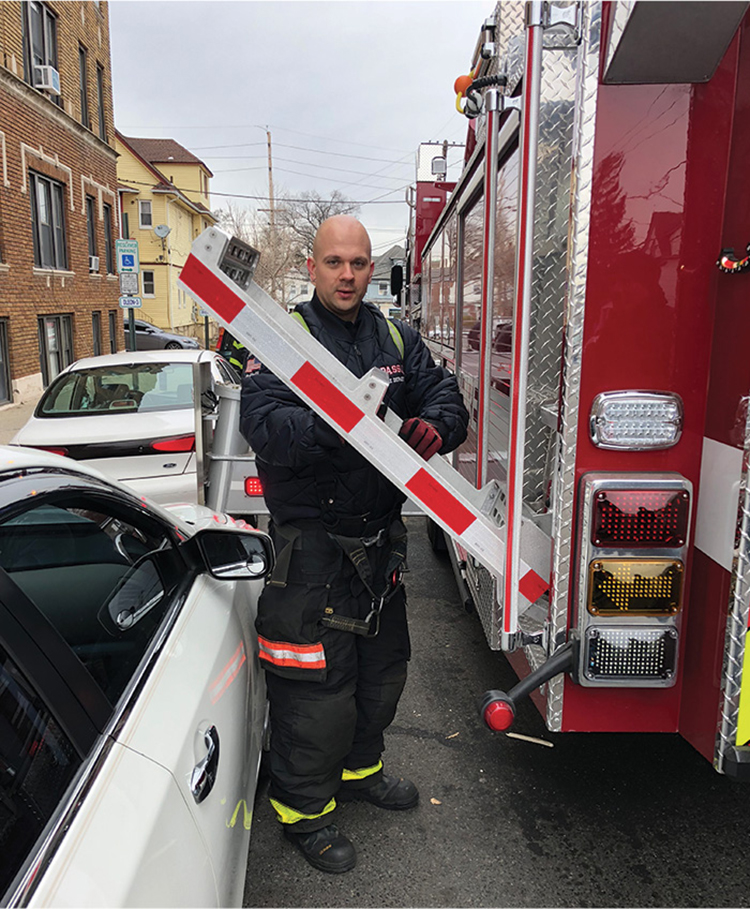
1 This hinged access ladder will not fully deploy because of the parked car. Luckily, there are other access ladders on the apparatus to reach the bucket; this is something apparatus committees should consider. (Photos by author unless otherwise noted.)
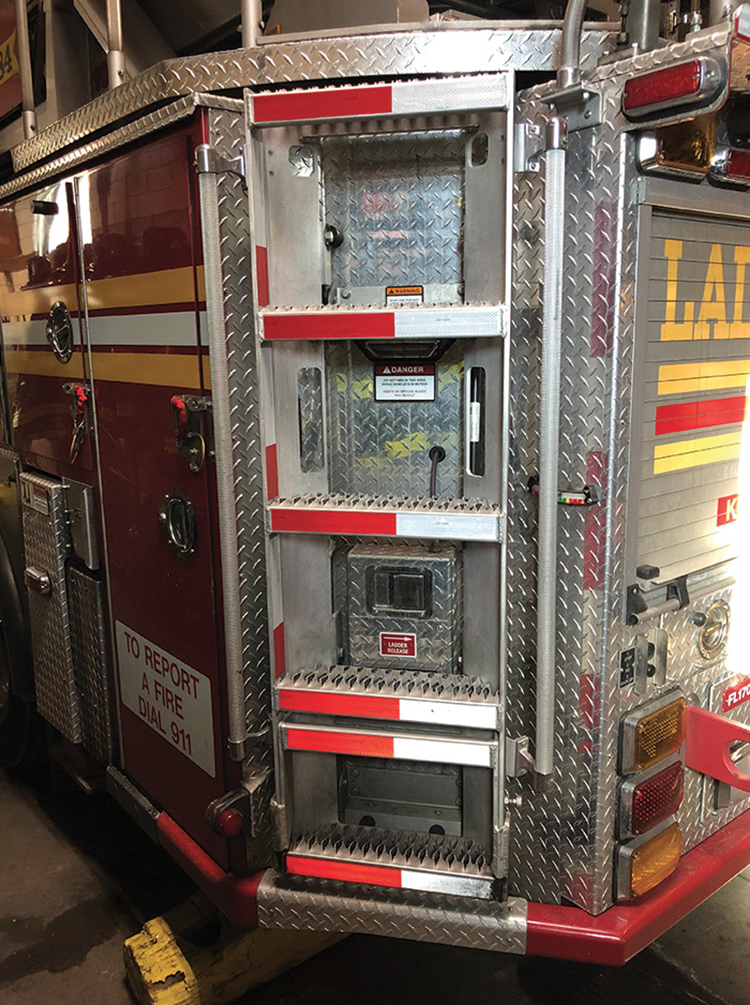
2 The design of the FDNY’s Ferrara rear-mount apparatus required it to be of an angular design, allowing an easier swing out of quarters and less damage to the access ladder.
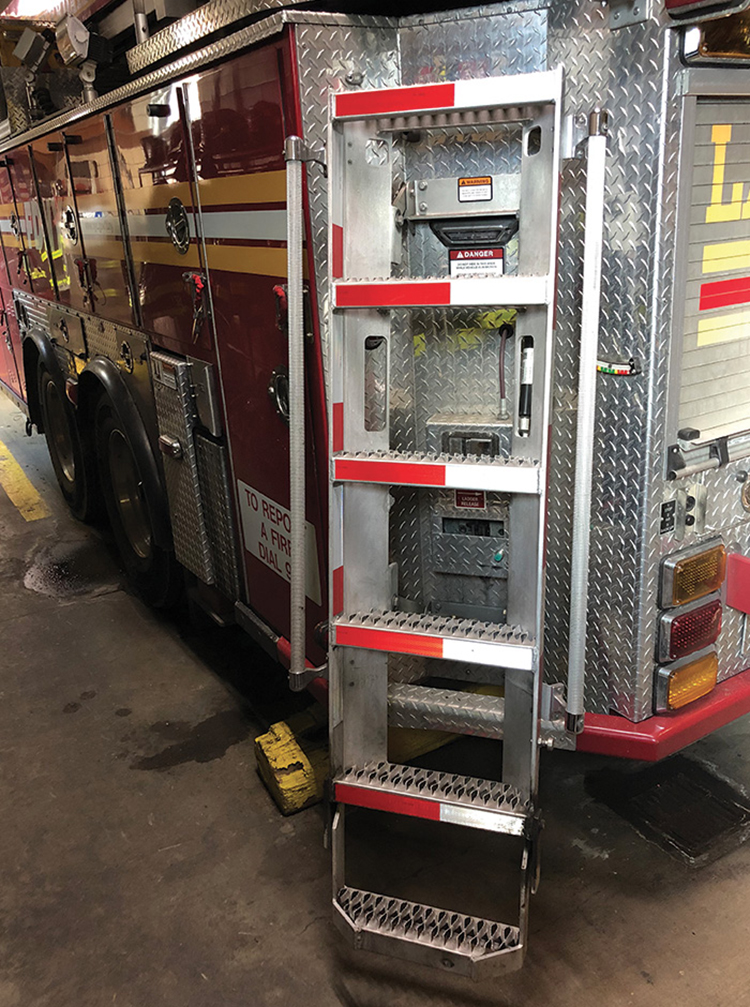
3 The FDNY’s Ferrara access ladder in the down position with lower step deployed.
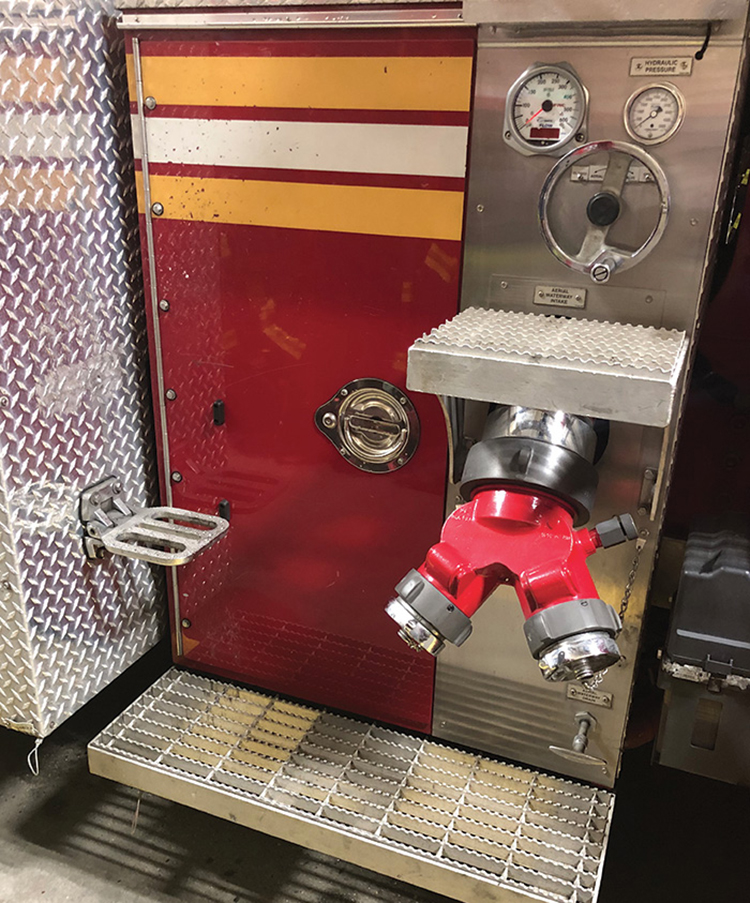
4 Single step pads are often mounted onto an apparatus for access to upper areas of the rig.
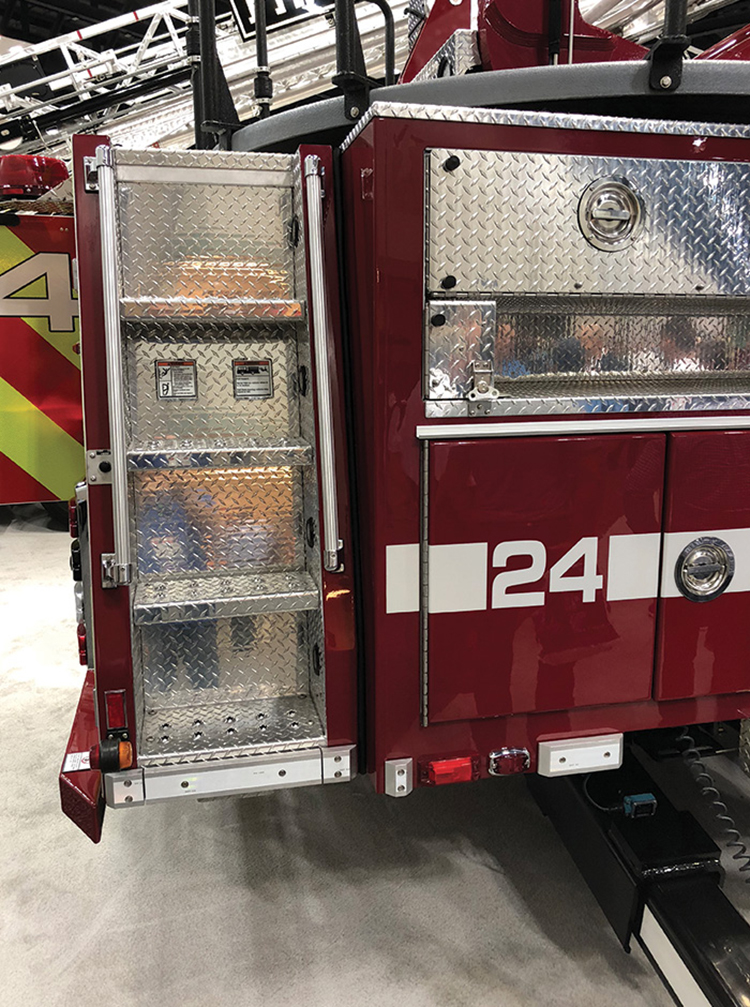
5 The E-ONE access stair/ladder is very well designed with lighting on each tread and double hand rails. The bottom step is a pull-out/drop-down style step, which is easy to deploy and doesn’t require a lot of clearance. It is in the closed position. (Photos 5-6 courtesy of JJ Cassetta.)

6 The E-ONE apparatus with the bottom step in the deployed position. On some grades, the step may not need to be deployed for firefighters to access the turntable.
If you’re operating in an older community or city, there are going to be streets in your district that are very old and narrow. Add that to placement of parked cars on either one or both sides, and you barely can open a compartment door. So, we must also consider: Will our access ladder offer us access to our work platforms in these situations? Unfortunately, if you only have one ladder on the rear of the rig providing access to the bucket, it can be a problem for a firefighter to access the area when he’s faced with an obstruction (photo 1). Plus, when the ladder is stowed away, the design and angle of the steps or structural make-up doesn’t permit a firefighter to climb it.
There are some solutions for this problem. If you have a midship apparatus, you may climb the access ladder/stairs near the turntable and walk down the side of the rig to the bucket. But, always use caution if the deck is slippery from rain or snowy conditions. Also, keep in mind that it’s very difficult for a fully dressed firefighter with self-contained breathing apparatus on to traverse around the pedestal and onto the deck. A severe injury can occur if the firefighter falls off the pedestal while making the transition. A solution to avoid these occurrences from happening would be to specify two access ladders on your rig and ones that fit your response district’s streets and obstructions your ladder company will encounter.
Another issue faced by many older cities is the combination of width of the firehouse doors, the narrow street the firehouse is built on, and the rig’s rear-end swing distance out of the firehouse for the apparatus to clear the door frame. If there is a no parking zone across the street and this isn’t an issue, consider yourself lucky. If not, your maintenance people better expect the occasional brushing up against the door frame or some paint to be scraped off from time to time. All too often in many cities, the no parking zone becomes a great spot to make a delivery or just be out of the car for a minute, and that’s when our run comes in. In situations such as these, some fire departments have changed the style and location of their access ladders to prevent hitting them up against the building and causing damage to the building, rig, or access ladder. These departments have specific specifications that their ladder apparatus must have an angular rear design, cutting the rear end at an angle to allow the rig to swing out of the firehouse easier and to maneuver through congested city streets. On this angular portion of the rig, the access ladder for the turntable is also mounted. Having the ladders in this position has reduced damaging them while pulling out of the firehouse. It also has reduced maintenance costs for the apparatus or firehouse repairs (photos 2 and 3).
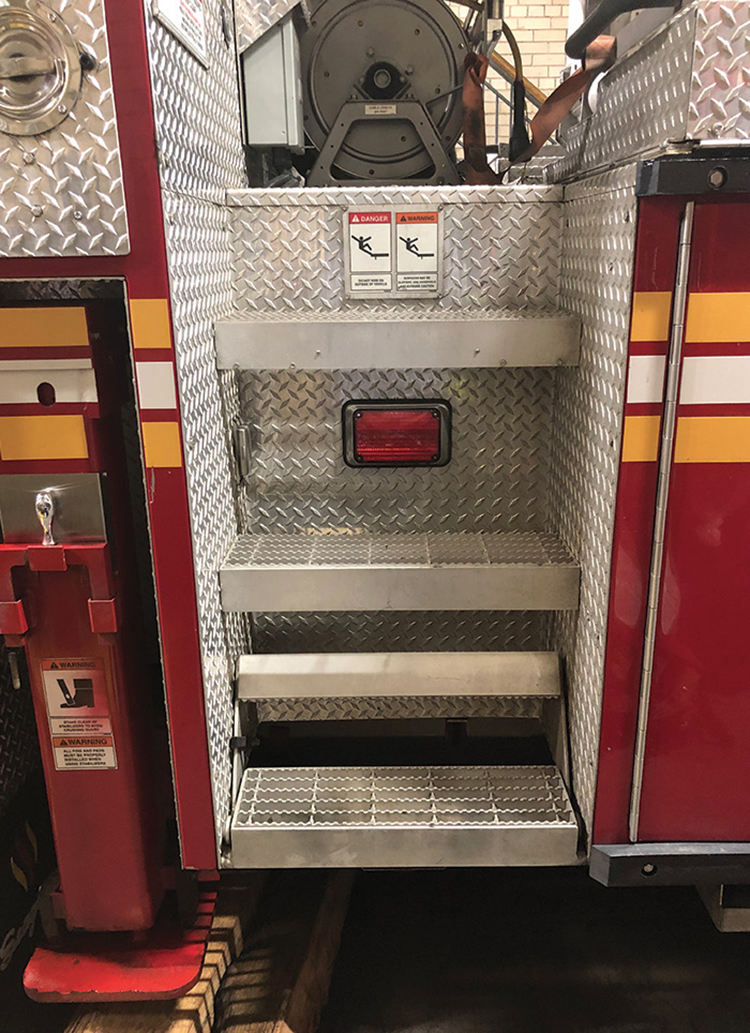
7 Access stairs leading up to an FDNY Seagrave tower ladder’s bucket are offered on both rear sides of the apparatus.

8 The hinged step on the Seagrave’s access stair requires minimum distance to deploy and put into place.
SINGLE FOLD-OUT STEP PADS
Fold-out steps can be as simple as single step pads mounted onto the body of the apparatus that must be manually folded down for a firefighter to gain access to an upper level. We often see these steps secured onto the rear wall of the cab, providing access up to a midmount aerial device’s turntable. In years past, these were very narrow and small steps, but today they are much wider to allow a firefighter’s boot full contact with the plate. Many of these fold-down step pads might be used in conjunction with a permanently mounted step or in a distinct pattern to allow access up to the turntable. Many engine companies may also have these types of steps to gain access to their upper level to retrieve equipment, readjust portable lighting, or manually use their prepiped monitor appliance (photo 4).
SINGLE-STEP PULL-OUT EXTENSIONS
Some manufacturers offer a simple solution to reducing the height it takes for a firefighter to reach the access ladder from the ground. Since bunker gear can limit some of the firefighter’s mobility compared to wearing just a station uniform, the distance from the ground to the first step should be easy to reach. With the apparatus having a permanently mounted access ladder on the rear of the rig, E-ONE has created a pull-out and pivot-down single step. The step is hard to spot and often overlooked when viewing the rig because it is in the same design as the side rub-rail (photos 5 and 6). To activate the step, disengage the locking release and slide the step out, and it hinges down into position. With the hand rails next to the ladder, the firefighter can use this first step to transition onto the access ladder and up to the turntable. With access stairs up to a pedestal or bucket, another version of a single-hinged stair can be found. Seagrave equips FDNY tower ladders with a hinged step on the stairs. The hinged step doesn’t need a lot of clearance to function or need to be used if the grade doesn’t require it. Remember though, when the apparatus is raised on its jacks and tormentors, the distance between the ground and rig increases and may require the steps to be used (photos 7 and 8).
ACCESS LADDERS/STAIRS
Larger fold-out access ladders also exist and come in a wide variety of styles and designs depending on the manufacturer you choose. Many of the newer designs have gas pistons mounted onto their assembly to assist when the ladder is being deployed and stowed away, making it a smoother transition and less likely for a firefighter to get his hand caught in the mechanism when operating it. Some of these ladders are also just the hinged type, which pivot downward when manually released from a rubber holding strap or bracket. These may or may not have gas piston assemblies to assist in deploying and stowing. There are also ladders that release from their holding brackets and pivot away from the apparatus a bit, then their lower step can be released if needed for easier access to the turntable. This lower access step may not be needed depending on the grade the apparatus is set up on.
Some apparatus may come with a section of stairs that offer access up to the turntable or to the bucket. These steps may take up some room when designing specific apparatus, and many departments might try to stay away from them when they are attempting to get all the compartment space they can. Many of these fixed stairs may have a pull-out lower step that is either of a hinged design or hidden design. Both of these steps are secured and need their releases disengaged to allow the step to be put into position. Normally with these stairs, it is only a one- or two-step extension design that offers firefighters an easier time in climbing up them (photos 10-13).
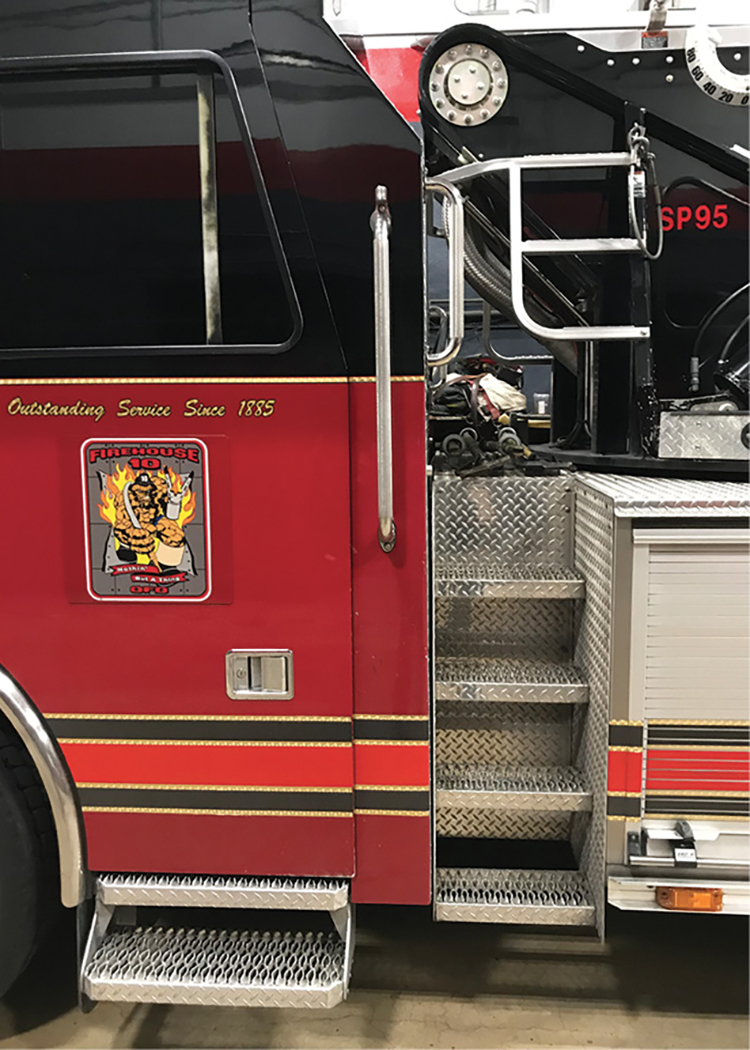
9 Access stairs to a Sutphen midmount aerial. (Photos 9-13 courtesy of JJ Cassetta.)

10 This Ferrara apparatus has a hinge-type design with gas cartridge assist that helps deploy and stow the access ladder.

11 This Ferrara’s access ladder is shown in the down position. Note that the lower section will hinge away from the apparatus when it is being deployed.
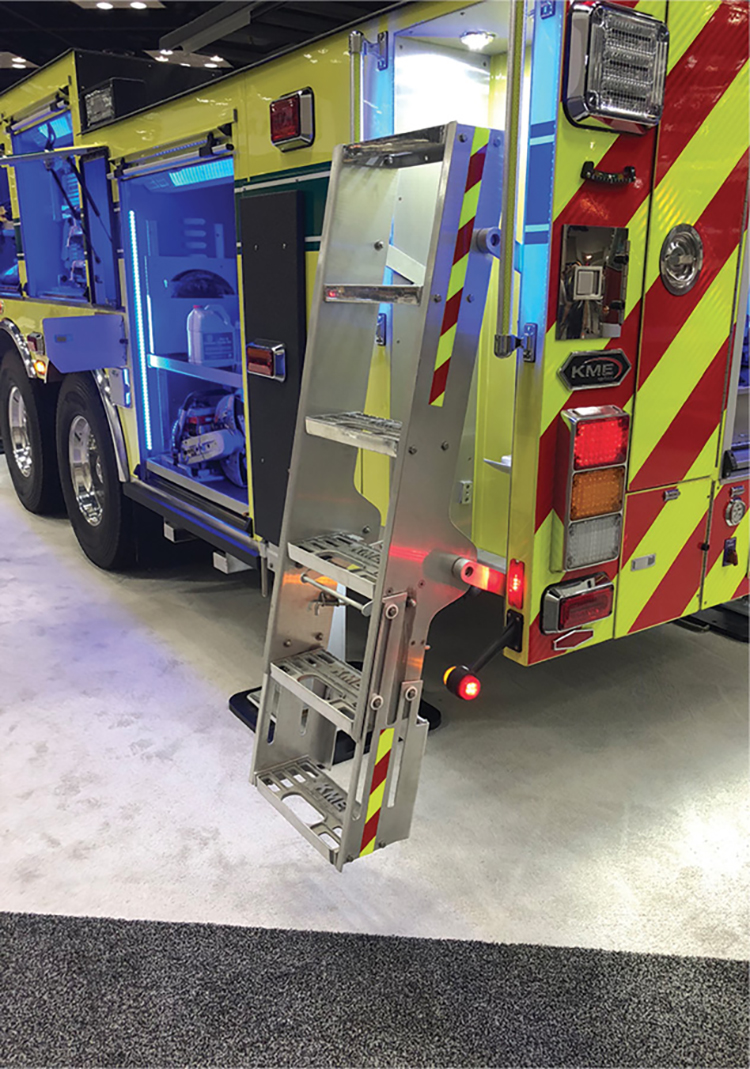
12 This KME apparatus has a hinged ladder that pivots out of its storage receptacle with a retractable bottom step. There is sufficient light near the ladder, and it has two hand rails for overall firefighter safety.
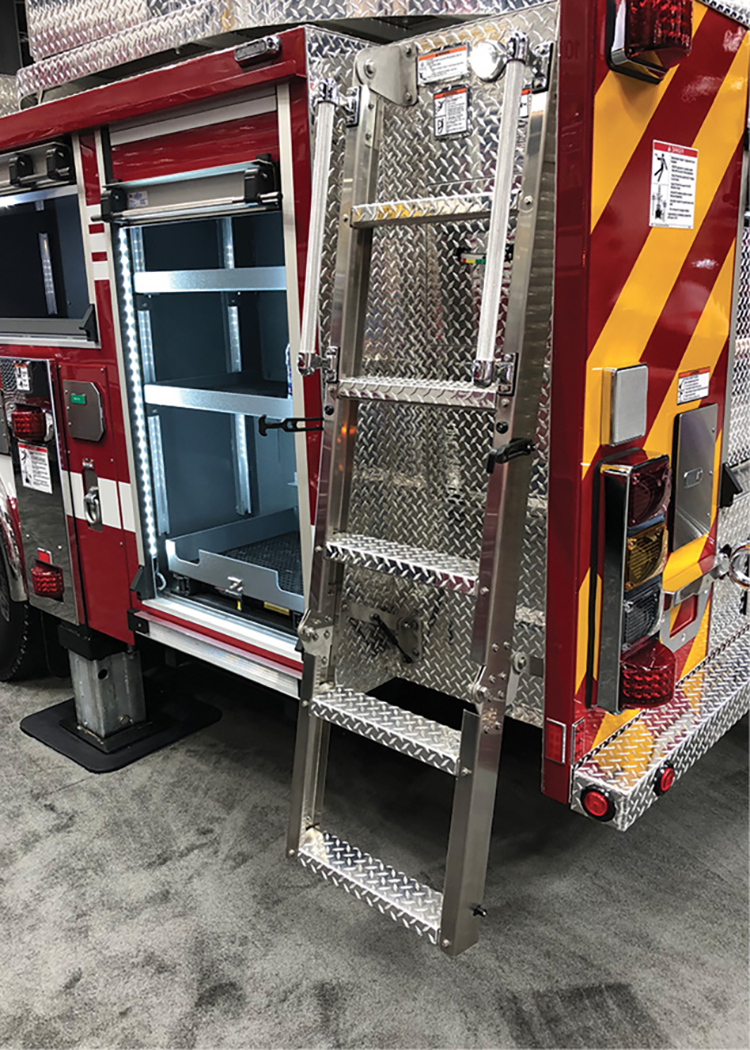
13 Spartan’s access ladder shown in the deployed position also has a gas cartridge design to assist in deploying and stowing. There are two rubber handle releases that allow the bottom of the ladder to hinge into position.
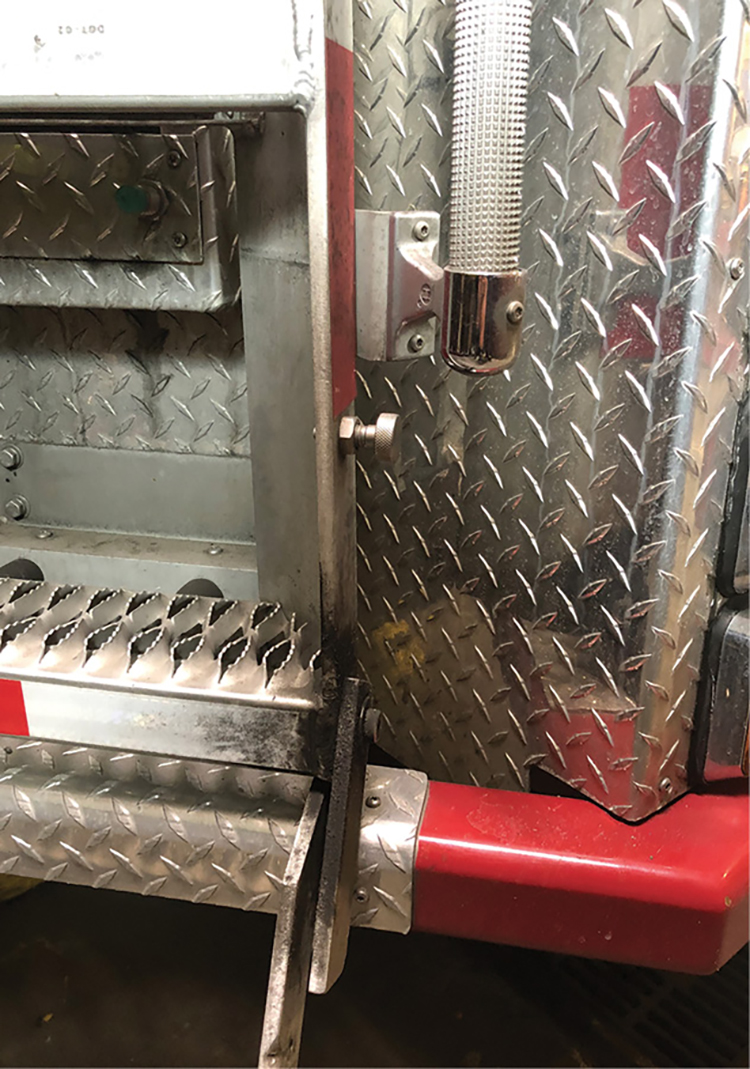
14 Maintenance must be performed to lubricate release mechanisms as per the manufacturer’s recommendations.
RELEASE LEVERS/ASSEMBLIES
One of the most common items we should mention about access ladders is the release lever and its accessibility and style. Firefighters often exit the crew cab in full personal protective equipment including gloves. We need to ensure that the levers and releases are big enough to allow a gloved hand to release them. Also, are they in an area where it’s easy to reach them? Often these releases can be a bit tricky to figure out or reach when you add the obstacle of the ladder that the firefighter might have to skirt around. Plus, often the firefighter is going to have a tool in his hand and possibly a saw over his shoulder on the way up to the ladder or bucket. If you have rubber release straps, ensure that the tab is large enough to grab with a gloved hand and know that over time, daily wear and tear may require them to be replaced. Metal releases should also be large enough to reach and manually engage with a glove on. These releases may need to be periodically lubricated to assist them in operating, and departments should follow the manufacturer guidelines for maintenance (photo 14).
MISCELLANEOUS ITEMS
Another area to talk about is access ladder style for the apparatus. Weather is a big factor across the country, and when we deal with firefighting, we always have to mention water. Water is and can be slippery on any given day on apparatus components. Many of these access ladder steps are designed with grating, slots, holes, or grooves to allow water run-off of stairs. In winter, water can freeze, and allowing it to drip down onto the ground vs. on the ladder is a better option than a firefighter falling off the top of the access ladder. Overspray from a loose or bad coupling can also spray water onto these stairs, so allowing the water to run off of them enhances our overall safety.
Lighting has continually improved with newer LED technology and we’ve been seeing that on many new apparatus. When we talk about lighting in the access stair area, we have to remember we want it bright because we’ll be operating a lot in the darkness. We should also watch where the lights are positioned in the stair area. Firefighters will be climbing with tools while going up and down the ladder, and these lights should be protected so they aren’t broken during the daily rigors of firefighting.
Hand rails and grab rails are also very important in this area. Ensure that the apparatus has enough of them—especially transitioning from the turntable or bucket back onto the access ladder. Firefighters should have something to hold onto or reach for while making the transition. Slips and falls account for many injuries on the fireground, and it’s our job to try and reduce them while we’re in the planning stages of drawing up specifications for a new ladder company apparatus.
Access ladders are an integral part of a ladder company apparatus. Researching and reviewing the design types and features should be done by your apparatus committee prior to purchasing a new aerial truck.
MICHAEL N. CIAMPO is a 33-year veteran of the fire service and a lieutenant in the Fire Department of New York. Previously, he served with the District of Columbia Fire Department. He has a bachelor’s degree in fire science from John Jay College of Criminal Justice in New York City. He is the lead instructor for the FDIC Truck Essentials H.O.T. program. He wrote the Ladders and Ventilation chapters for Fire Engineering’s Handbook for Firefighter I and II (Fire Engineering, 2009) and the Bread and Butter Portable Ladders DVD and is featured in “Training Minutes” truck company videos on www.FireEngineering.com. He also writes the back page column ON FIRE in Fire Engineering.

